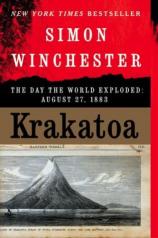Krakatoa: The Day the World Exploded: August 27, 1883
Review
Krakatoa: The Day the World Exploded: August 27, 1883
By late summer of this year, 120 years will have passed since the
greatest natural disaster to occur on this planet since mankind
began recording history some 30,000 years ago.
It was exactly 10:02 a.m. on Monday, August 27, 1883 when the small
volcanic island of Krakatoa in the Sunda Strait between Java and
Sumatra blew itself out of existence with an explosion that was
heard thousands of miles away and that resulted in the deaths of
over 36,000 people. That eruption is believed to be the loudest
sound ever heard by human ears.
As Simon Winchester points out in this latest of his detailed
historical-scientific investigative books, the vast majority of
those 36,417 victims were killed not by the explosion itself, but
by the enormous tsunami it created. This moving mountain of
seawater wiped out whole towns; devastated the social and economic
life of a region measured in thousands of miles; and was recorded
on tide gauges as far away as France.
Winchester specializes in detailed accounts that shine light into
odd or forgotten corners of history. His two most recent successful
efforts in that genre were THE MAP THAT CHANGED THE WORLD and THE
PROFESSOR AND THE MADMAN. Now he has crafted a vividly written book
of 400-plus pages about an event that was over in a matter of
hours. KRAKATOA is certainly full of digressions that have only
tangential relevance to its main subject --- but those digressions
are so well researched, beautifully written and just plain
interesting that they become assets rather than liabilities. The
reader does not really object to the fact that the eruption doesn't
begin until past the halfway point in Winchester's text.
The preliminaries that lead Winchester up to August 27th involve,
among other things, giving proper credit to people like Alfred
Russel Wallace --- whose theories of evolution paralleled those of
Charles Darwin --- and Alfred Lothar Wegener, whose prescient views
on continental drift, once ridiculed, were scientifically confirmed
only in the 1960s. We get lengthy side-essays on subjects such as
the science of plate tectonics; the spread of information
technology spurred by the laying of the Atlantic Cable; the flora
and fauna of the southwest Pacific; the history of colonial
exploitation in that area by the British and Dutch; and the growth
of international trade that placed Krakatoa directly on one of the
busiest sea lanes in the world on that August morning. His thesis,
backed by impressive geological evidence, is that Krakatoa had
certainly erupted many times in the distant past --- before
recorded history began --- and that it will inevitably do so again
sometime in the unforeseeable future.
The small volcanic island had given plenty of warning. There had
been a serious eruption the previous May and the warning signs of
the big bang of late August were obvious. Yet, as so often happens
in both natural and manmade catastrophes, no one put the pieces of
the puzzle together in time. The eruption actually began on Sunday
the 26th, but no one was prepared for the incredible disaster of
the next morning. The captain of a passing British ship, awestruck,
wrote in his log: "A fearful explosion...I am writing this blind in
pitch darkness...The eardrums of over half my crew have been
shattered. My last thoughts are with my dear wife. I am convinced
that the day of judgment has come."
The island of Krakatoa --- six miles long and two miles wide ---
was largely destroyed. Only tiny fragments of it remain today,
along with an island, locally known as "The Child of Krakatoa,"
which has risen from the seabed where the volcano's crater once
stood.
Winchester tells this story with masterly vividness. His research
is thorough and he has the ability to translate things like the
records of the pressure gauge at the gas works in Batavia
(present-day Dakarta), 90 miles away, into telling historical
evidence. He does seem, however, to be on somewhat shakier ground
in contending that the catastrophe contributed to a rise in Islamic
Fundamentalist fervor that has survived, grew and fed the political
turmoil that grips independent Indonesia to this day. That may be
stretching things rather further than is logical.
For American readers, KRAKATOA will serve as a vocabulary builder,
with its references to genever (an alcoholic drink), godowns
(warehouses), pye-dogs (??), solfataras (volcanic fissures) and
other such technical terms. But readers will also learn about
"subduction zones" and the prime role they play in the continuing
slow-motion subterranean dance going on beneath the feet of all of
us as continental plates rub up against each other, causing
volcanic matter to gush up or be dragged down to await further
Krakatoas. It seems that, if mankind somehow escapes blowing itself
up, nature may do the job for us down the road in a few million
years.
Reviewed by Robert Finn (Robertfinn@aol.com) on January 3, 2011
Krakatoa: The Day the World Exploded: August 27, 1883
- Publication Date: November 30, -0001
- Genres: Nonfiction
- Paperback: 448 pages
- Publisher: Harper Perennial
- ISBN-10: 006093736X
- ISBN-13: 9780060937362




